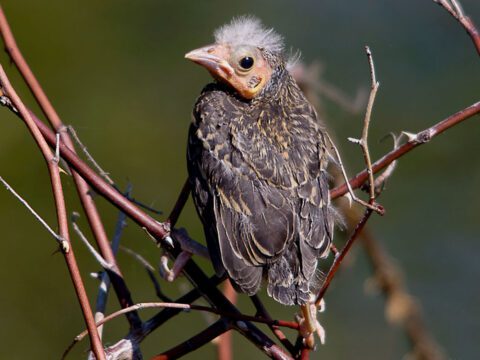Birds Are Less Abundant When Periodic Cicadas Emerge
By Laura Erickson
April 15, 2011
When he was six years old, Walter Koenig, now a senior scientist at the Cornell Lab of Ornithology, conducted his first biological field study, observing 17-year cicadas. He grew up within a major population center of periodic cicadas—a large insect whose population emerges every 17 years.Their emergence in 1956 was so memorable that even today he remains fascinated by them. He and collaborators from the University of Maryland and the U.S. Forest Service will have a paper in an upcoming issue of Ecology titled: “Avian predators are less abundant during periodical cicada emergences, but why?”
Juvenile cicadas, which are related to leafhoppers and aphids, spend several years underground before emerging for a short adult stage. In most species some adults emerge each summer as the rest of the population remains underground. But in seven species found only in eastern North America, populations are developmentally synchronized. Juveniles of these cicadas remain underground for exactly 13 or 17 years, emerging as adults all at once. “These are very special events,” Koenig said. He’s not the first to be amazed by them. The first mention of a periodical cicada mass emergence dates back to 1666 in a paper entitled “Some Observations of swarms of strange Insects, and the Mischiefs done by them,” in the first volume of the first scientific journal ever published, the Philosophical Transactions. After 350 years, nobody can explain why these cycles are prime numbers, but many people believe it somehow makes it harder for predators to track their cycles.
Cicadas are large, non-toxic, and have no physical defenses against predators. It seems intuitive that birds would gorge on them when they emerge. But Koenig’s research team found, using data from the Breeding Bird Survey and Christmas Bird Count, that many insectivorous birds declined in number during the 1987 and 2004 emergences of the “Great Eastern Brood,” another population with a 17-year cycle. Of the 24 species they investigated, they found that only two species, Yellow-billed and Black-billed cuckoos, increased during cicada emergences, while 16 decreased.
Koenig’s team investigated three hypotheses: Does the loudness of the cicadas’ calls make it too hard for researchers to detect singing birds that are present? Does that loudness drive birds into areas with fewer cicadas? Are bird numbers regionally lower in emergence years, even outside the range of cicadas? Koenig said, “As unlikely as it seems, these birds really do seem to be at lower densities—there really are fewer crows and others out there. It looks like the cicadas are somehow engineering the bird populations by their cyclic life-history to be less common when emergences take place, reducing predation pressure. The mechanism behind this is obscure, but the fact remains that this provides a glimmer of an ecological explanation for why there might be 13- and 17-year cycles.”
Originally published in the Spring 2011 issue of BirdScope.

All About Birds
is a free resource
Available for everyone,
funded by donors like you
American Kestrel by Blair Dudeck / Macaulay Library



